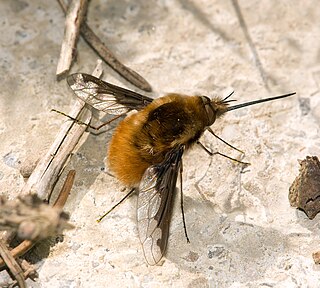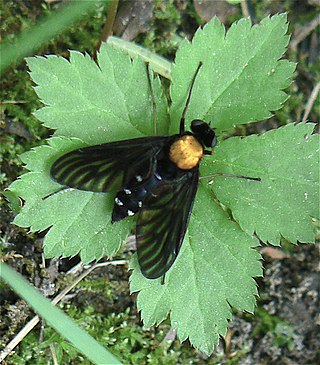
The Bombyliidae are a family of flies, commonly known as bee flies. Adults generally feed on nectar and pollen, some being important pollinators. Larvae are mostly parasitoids of other insects.

The Heleomyzidae is a small family of true flies in the insect order Diptera. Over 740 described species of Heleomyzidae occur in about 76 genera distributed throughout the world.

Chrysopilus is common, worldwide genus of predatory snipe flies. There are approximately 300 species in the genus, including fossil members that are sometimes found in amber.

The Apioceridae, or flower-loving flies, are a small family of flies, all in the single genus Apiocera. They occur mostly in dry, sandy habitats in the deserts of North America, South America, and Australia. Other genera formerly placed in Apioceridae are now in Mydidae.

The Pyrgotidae are an unusual family of flies (Diptera), one of only two families of Cyclorrhapha that lack ocelli. Most species are "picture-winged", as is typical among the Tephritoidea, but unlike other tephritoids, they are endoparasitoids; the females pursue scarab beetles in flight, laying an egg on the beetle's back under the elytra where the beetle cannot reach it. The egg hatches and the fly larva enters the body cavity of the beetle, feeding and eventually killing the host before pupating. In the United States, some species of Pyrgota and Sphecomyiella can be quite common in areas where their host beetles are abundant. Like their host beetles, these flies are primarily nocturnal, and are often attracted to artificial lights.
Chetogaster is a genus of bristle flies in the family Tachinidae.

Arachnomyia is a genus of flies in the family Dolichopodidae. It is known from Australia.

The Helosciomyzidae are a small family of flies found exclusively in the Southern Hemisphere. With the exception of the South American genus Sciogriphoneura, helosciomyzids occur only in Australia and New Zealand.
Ironomyiidae is a small family of flies in the order Diptera. Historically, they had been included in the family Platypezidae, and includes three extant species within the single extant genus Ironomyia endemic to Australia and a number of extinct fossil genera from North America and Asia extending back to the Early Cretaceous.
Atherimorpha is a genus of snipe fly of the family Rhagionidae.

Empidinae are a subfamily of empidoid flies. They are mainly predatory flies like most of their relatives, and generally small to medium-sized. Most species are flower visitors and they can be effective pollinators.

Anthracinae is a subfamily of bee flies in the family Bombyliidae. There are more than 80 genera and 2,000 described species in Anthracinae.
Mariobezziinae is a subfamily of bee flies in the family Bombyliidae. There are about 10 genera and at least 50 described species in Mariobezziinae.
Dasyomma is a genus of flies in the family Athericidae.
Exeretonevra is a genus of flies in the family Xylophagidae.

Tapeigaster nigricornis is a species of fly in the family Heleomyzidae. It is endemic to Australia, occurring in New South Wales, Queensland, South Australia, Tasmania, Victoria, and Western Australia. It is the most commonly seen species of Tapeigaster.
Tapeigaster annulipes is a species of fly in the family Heleomyzidae. It is endemic to Australia, occurring in New South Wales, Queensland, South Australia, Tasmania, and Victoria. It is common and widely distributed within this range and can be found in forested and urban areas alike.
Diochlistus is a genus of flies in the family Mydidae.











